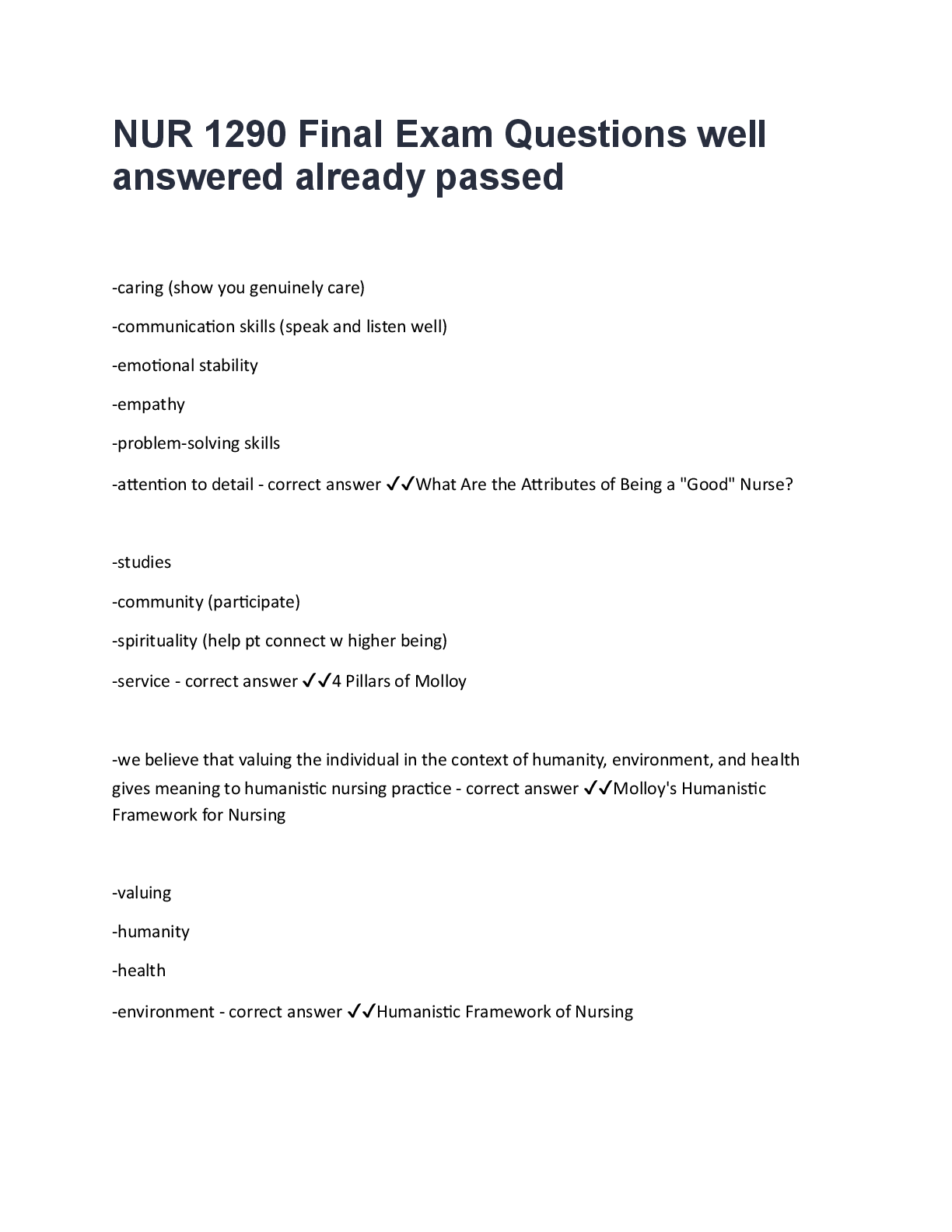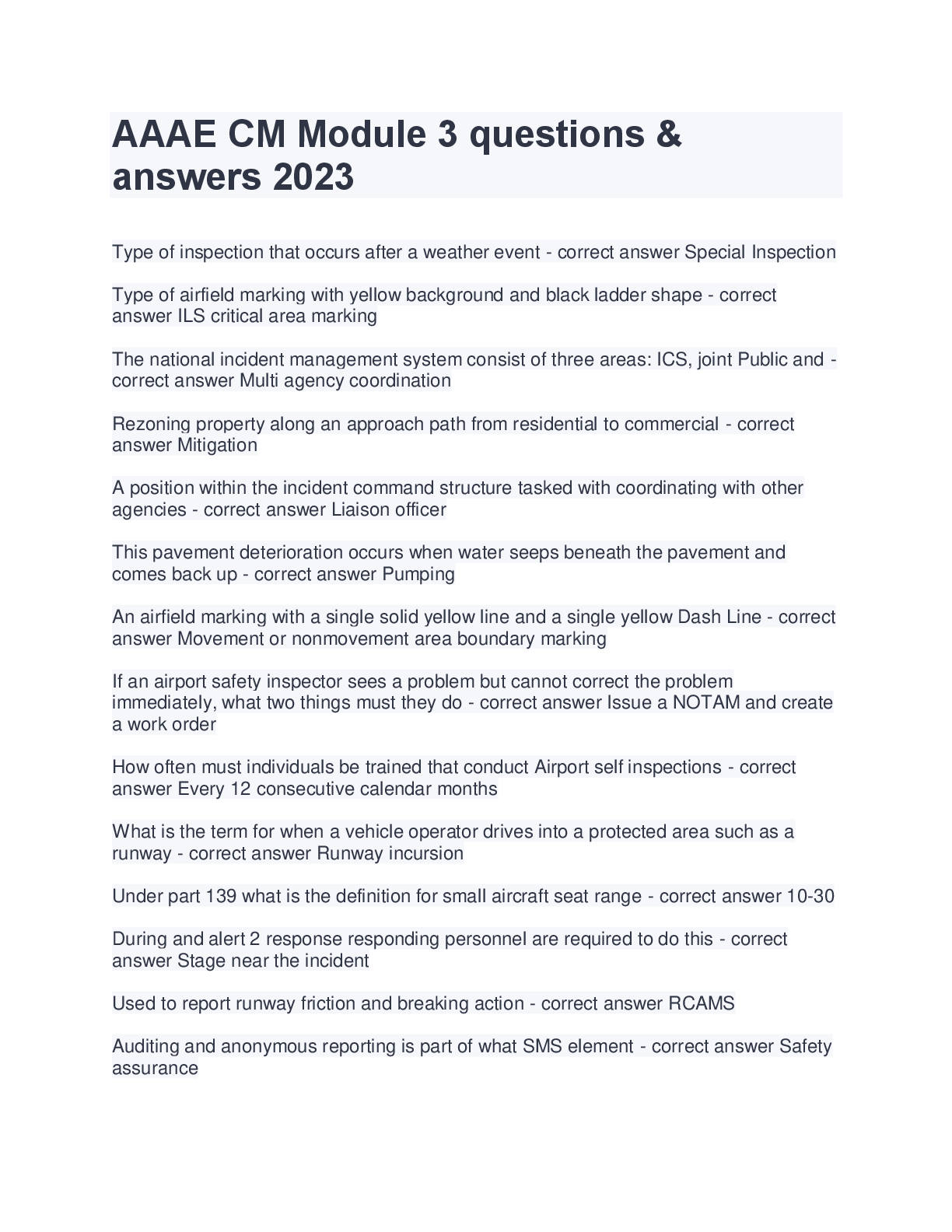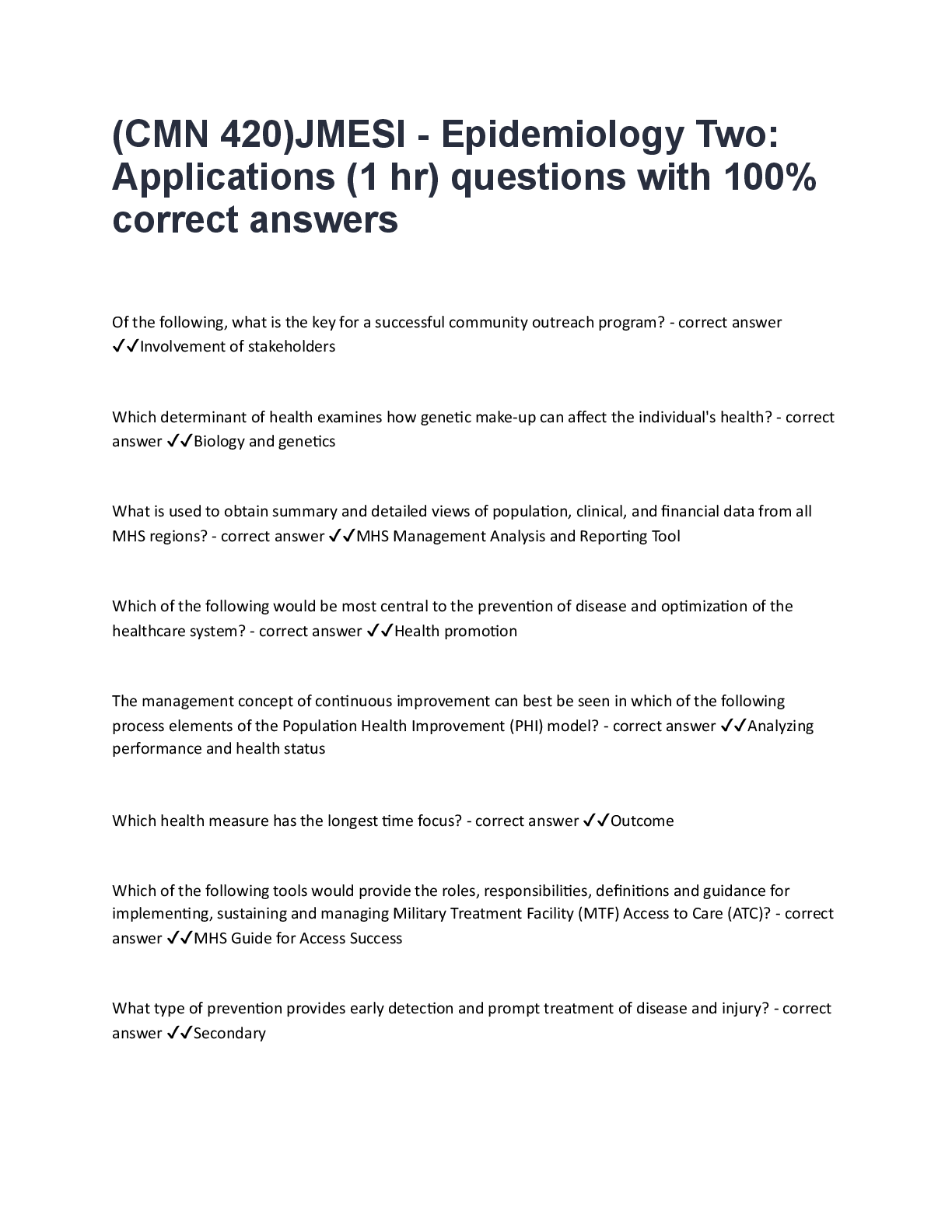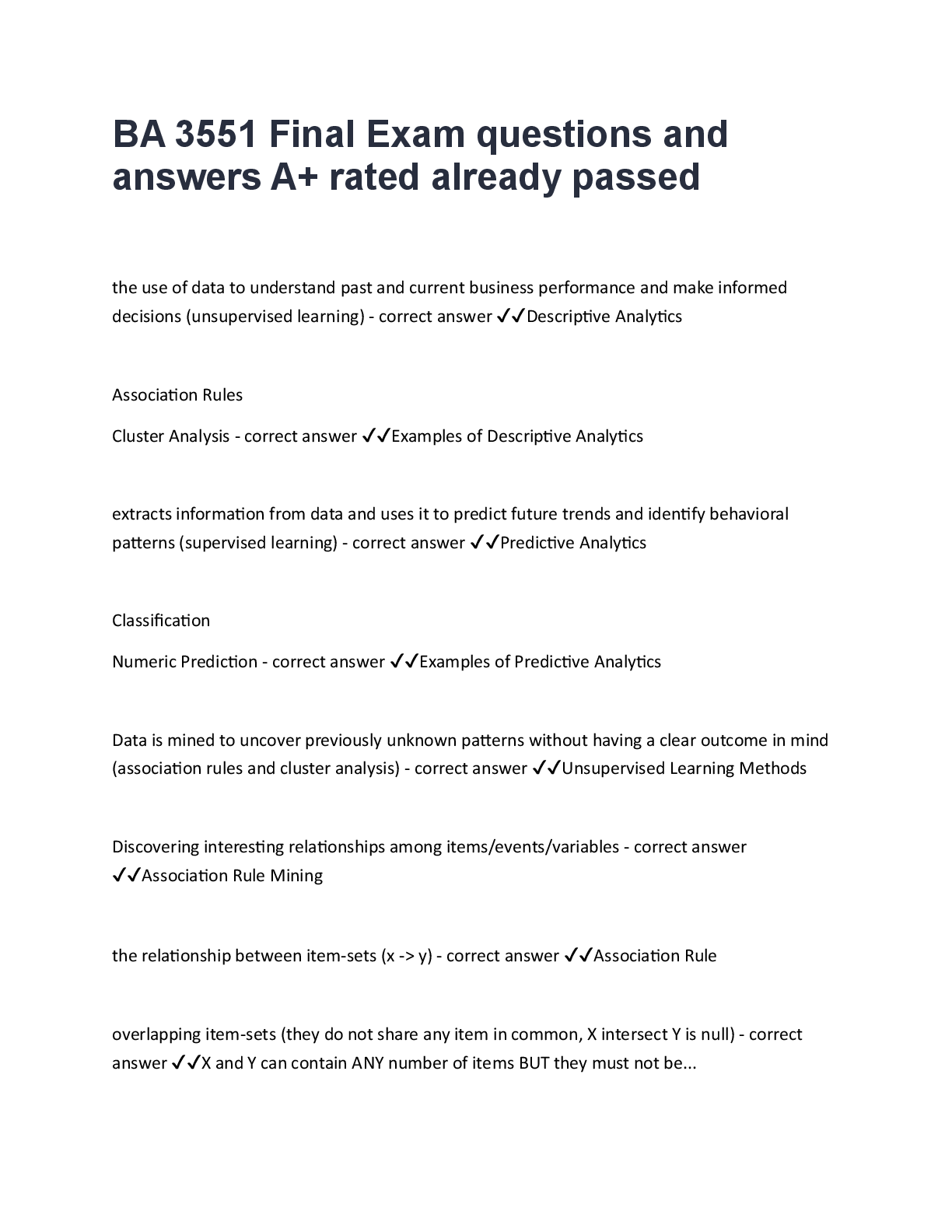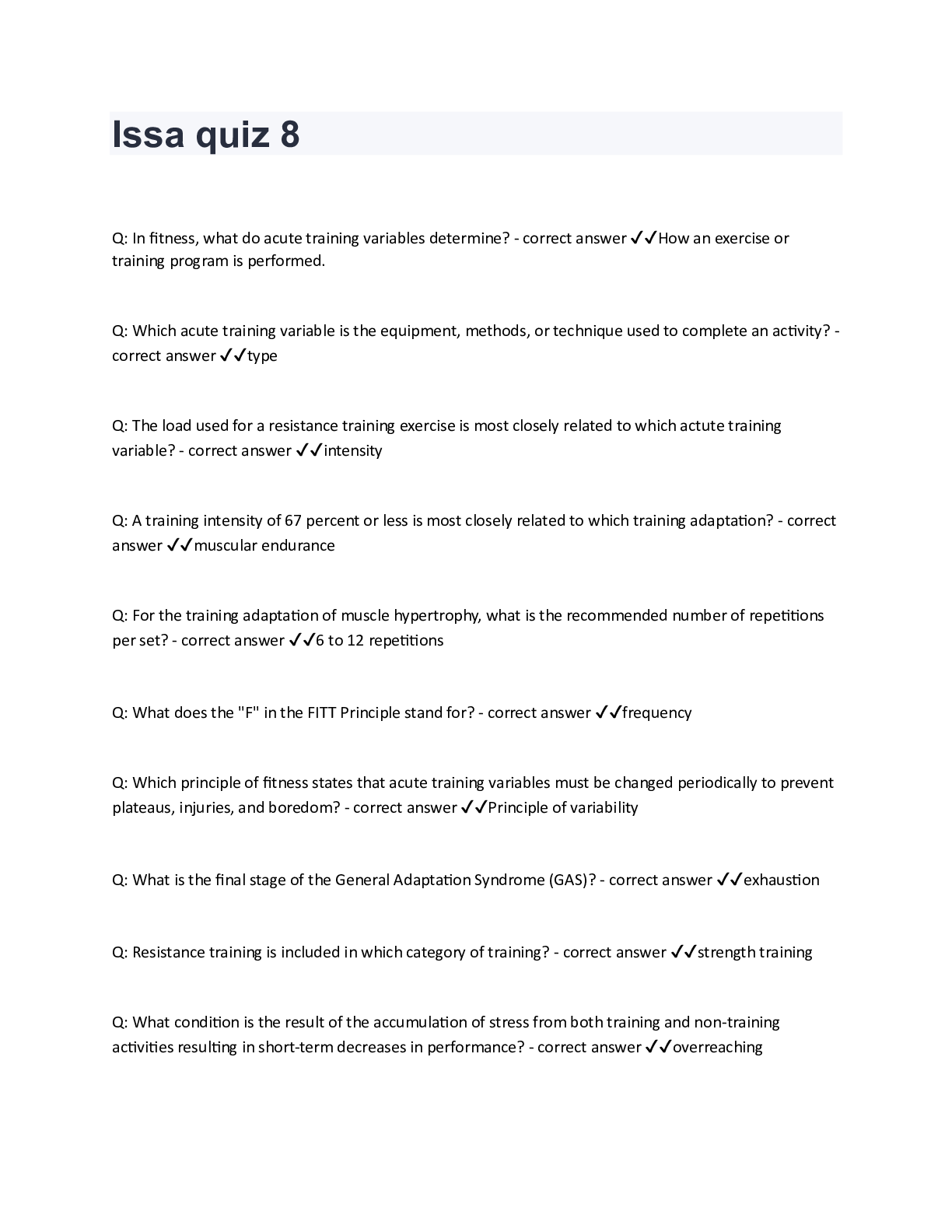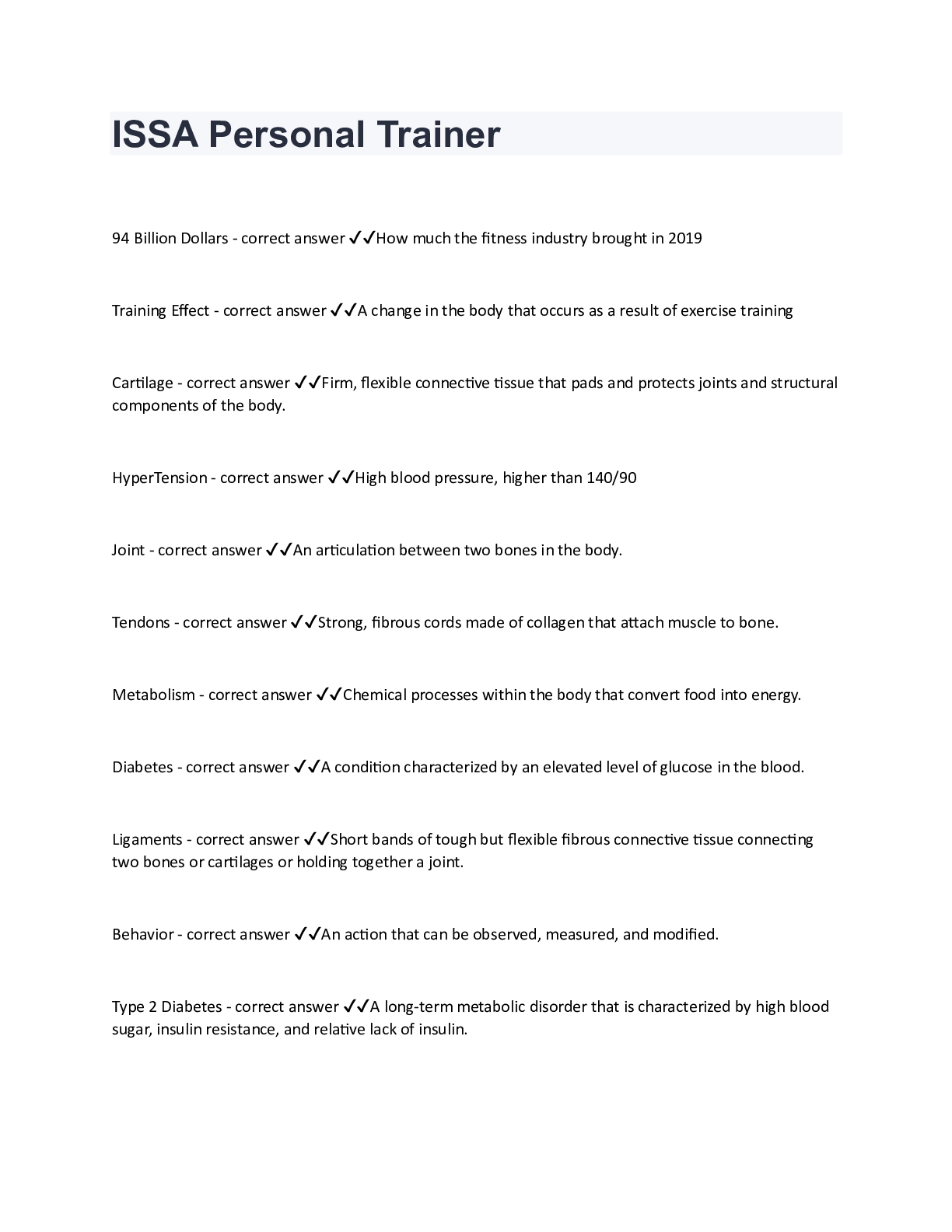AMLS Test questions and answers latest 2023
Document Content and Description Below
What condition is most likely to cause respiratory acidosis? In larger doses narcotics induce respiratory depression and eventually respiratory arrest. AMLS Page 95 A 65-year-old female compla... ins of chest pain that feels like "aching" in her chest. It has become progressively worse over several days. Her temperature is 38.3 degrees C (100 F). Which finding will help narrow your differential diagnosis to pericarditis? 12 lead ECG will demonstrate global ST-segment elevation in almost every lead. AMLS Page 128 During compensatory shock, the renin-angiotensin-aldosterone system is activated to cause a/an: This selective perfusion occurs during the ischemic phase of shock. AMLS Page 146 (To stop kidneys from excreting fluid and keeping it in the vasculature, therefore increasing BP) lntrabdominal bleeds, like pancreatitis, often present with discoloration or bruising around the umbilicus. This physical exam finding is known as: Cullen's sign is a blue discoloration around the umbilicus. AMLS Page 235 What clinical findings are most commonly associated with a pulmonary embolus? Clear breath sounds with tachypnea. Signs and Symptoms AMLS Page 113 A 50 year old female has called 911. She complains of shortness of breath and chest. discomfort. Assessment reveals her skin is pale, moist and cool. BP is 102/68, R 24, labored with crackles, P of 130 and regular. Which type of shock is most likely occurring? The patient's respiratory rate is increased, and crackles caused by pulmonary edema can be heard on auscultation. Cardiogenic Shock Signs and Symptoms. AMLS Page 164 Patients with a history of COPD that present with an acute onset of shortness of breath are likely to have which condition? Elements of patient history that suggest PE include acute onset of shortness of breath. AMLS Page 114 An elderly patient with a 1 week history of productive cough and wheezing notices an increase in difficulty in breathing when grocery shopping. Further assessment reveals pursed lip breathing, rhonchi, and minimal jugular vein distention. Which diagnosis should the healthcare provider suspect? Signs and Symptoms of COPD. AMLS Page 85 A 45 year old patient is found supine on the floor. Healthcare providers note pinpoint pupils, shallow respirations and vomitus in and around the mouth. What course of action should be implemented next? This is self explanatory (Suction Airway) A 20 year old female presents with a 2-day history of dyspnea, non-productive cough, chest tightness audible wheezing. Further exam reveals no fever or strider. The patient has rapid respirations with difficulty exhaling. Which diagnosis is most likely? These are textbook signs of asthma Signs and Symptoms.AMLS Page 83 Anaphylaxis is most associated with which physiological event? The cutaneous reaction may be observed as flushed, warm skin resulting from vasodilation and uticarea. AMLS Page 162 An elderly patient is receiving care at home while recuperating from recent knee surgery. She developed post a operative infection and has been on antibiotics for quite sometime. She is complaining of foul smelling diarrhea, and abdominal cramping and loss of appetite. Based on this presentation, the provider should suspect? Signs and Symptoms Patients with this illness have diarrhea that is not bloody but has a characteristic foul odor. Abdominal pain and cramping are present in about 22% of patients. AMLS Page 319 (C-DIFF) Acute Respiratory Distress Syndrome (ARDS) is characterized by what pathological change? Pathophysiology AMLS Page 88 (Caused by diffuse damage to the alveoli, perhaps as a result of shock, aspiration of gastric contents, pulmonary edema or hypoxic event. Begins with a breakdown of the alveolar-capillary border that allows fluid to seep into the alveoli, decreasing gas exchange in the lungs. Healthcare providers are responding to a near-drowning at a local lake. The patient is experiencing uncontrollable shivering and complains of nausea and weakness. The patient had been treading water for 25 minutes and now presents with tachycardia and rapid respirations. Core body temperature is 93.2°F (34°C). Which diagnosis is most likely? 89.6F - 95.0F (Mild Hypothermia) AMLS Page 338 Continuous positive airway pressure would be most appropriate in treating which patient? 22 year old with severe asthma and not responding to nebulizer treatments AMLS Page 72 A local businesswoman has returned from missionary work in South Africa. She is complaining of night sweats,chest discomfort and a persistent cough for several weeks. Which underlying diagnosis is most likely causing these symptoms? Signs and symptoms of TB include persistent cough for 2-3 weeks, night sweats, headache, weight loss, hemoptysis, and chest pain. AMLS Page 301 What is the initial treatment for a patient experiencing Hyperosmolar Hyperglycemic Non-ketotic Syndrome (HHNS)? The patient may have significant volume depletion. Begin IV fluid resuscitation immediately. The initial fluid of choice is 0.9% normal saline (crystalloid solution). AMLS Page 270 When assessing geriatric patients, infectious disease is more difficult to identify for all the following reasons EXCEPT Older Adult Patients. AMLS Page 325 Your patient has had a seizure secondary to a nerve agent exposure. What medication would be best to diminish the seizure? If seizures develop administer diazepam (Valium) or lorazepam (Ativan). AMLS Page 424 (Treat seizure before treating for the exposure to the nerve agent) A caregiver for a quadriplegic patient notes an onset of difficulty in breathing and anxiousness in her patient. Further assessment shows a temperature of 101.2°F (38"C), P 128, BP 86/68, and R 24. Physical exam shows the skin is warm and urine in the Foley catheter is dark yellow and cloudy. This patient is most likely experiencing what type of shock? AMLS Page 159, Table 4-11 (Septic Shock) Respiratory Alkalosis may occur as a result of? Some causes of primary respiratory alkalosis include aspirin overdose, anxiety reaction, and pulmonary embolism. See table AMLS Page 272. A 22-year old male has recently undergone a surgical procedure to repair an injury to the thoracic vertebrae T4-T6. Assessment indicates the patient is alert and oriented, bradycardic, hypotensive and has warm dry skin which type of shock is most likely occurring? In neurogenic shock the patient is often both bradycardic and hypotensive. AMLS Page 149. Warm, dry, pink skin, decreased BP, alert, normal capillary refill. AMLS Page 157 table 4-9 An age related change that increases the risk of respiratory compromise is Reduced lung compliance due to calcification of cartilage in the trachea and bronchioles and calcification of interstitial tissue. AMLS P. 98 A patient complaining of a 3-day history of left, lower abdominal pain describes it as sharp in nature and, during the focused physical exam, the pain intensifies during palpation over the site. Differentials should include Ectopic pregnancy or diverticulitis (Question does not state the PT is female, but pick ectopic pregnancy) Paroxysmal Nocturnal Dyspnea is most common in patients with a history of? AMLS Page 60 Table 2-1 (Left-sided heart failure) The most common underlying medical conditions found in patients with acute pancreatitis is The disease is thought to be caused by cholelithiasis (gall stones) or alcohol abuse in more than 90% of cases. AMLS Page 235 The patient presents with a history of fever and an upper respiratory infection. Historical Information reveals increasing water intake, orthostatic hypotension and an Increase in urination. You suspect these symptoms are caused by? This is hyperglycemic DKA. Patients with DKA are dehydrated and appear ill. They usually report polydipsia (great thirst), polyphagia (excessive hunger), and polyuria (excessive urination). Patients with severe cases will exhibit altered mental status, tachycardia, rapid breathing and orthostatic changes. AMLSPage 268 The healthcare provider is assessing a 60 year-old female patient with complaints of indigestion and mild upper abdominal discomfort. This presentation should prompt the provider to: Indigestion and mild upper abdominal pain discomfort should prompt you to evaluate the patient for acute coronary syndrome. AMLS Page 225 You are dispatched to the home of a 32 year old patient with a history of Graves disease. The patient was in the ER earlier today for some "tests for my ulcers". He received contrast and was discharged. He is now complaining of not feeling well, chest pain and palpitations. You note an anxious patient with fine tremors. He is diaphoretic and has a fever if 101.5. BP 100/62, P156, R 30, Glucose 133. Which of the following are management considerations for this patient? This is a thyroid storm. The goals of pharmalogic treatment in the prehospital setting are to block the peripheral adrenergic hyperactivity the thyroid hormones elicit (tachycardia, fever, anxiety, and tremors). This can be achieved by administering beta blockers. The drug of choice is propranolol. Treatment AMLS Page 261 A patient presents anxious with difficulty in breathing and chest pain. An assessment reveals hypotension, muffled heart tones and distended neck veins. There is a past medical history of pericarditis. The provider notes that there is decrease in systolic blood pressure when the patient inhales. Which diagnosis would be considered with this presentation? The signs and symptoms are usually described in a triad including hypotension (low CO), distended neck veins (high right sided heart pressures), and muffled heart tones (fluid outside the heart) Signs and Symptom AMLS Page 119 (Pericardial Tamponade) Metabolic acidosis is best described by which arterial blood gas interpretation? Metabolic acidosis is caused by a deficiency of bicarbonate ion (base) and and excess of hydrogen ion (acid). In the acute stage the body's physiologic response is to hyperventilate and compensate by reducing PaCo2. AMLS Page 273 If untreated, a cardiac tamponade will present with signs and symptoms of which type of shock? Cardiac tamponade occurs when fl [Show More]
Last updated: 2 years ago
Preview 1 out of 7 pages

Buy this document to get the full access instantly
Instant Download Access after purchase
Buy NowInstant download
We Accept:

Also available in bundle (1)

Package deal for AMLS 2023
AMLS Pretest v 1.11 questions l Fully solved 2023 Medical/AMLS Final review latest 2023 graded A+ to pass AMLS Final questions with complete solution latest 2023 Advanced Medical Life Support...
By Favourfourtune 2 years ago
$54.5
8
Reviews( 0 )
$12.00
Can't find what you want? Try our AI powered Search
Document information
Connected school, study & course
About the document
Uploaded On
Feb 07, 2023
Number of pages
7
Written in
Additional information
This document has been written for:
Uploaded
Feb 07, 2023
Downloads
0
Views
94

